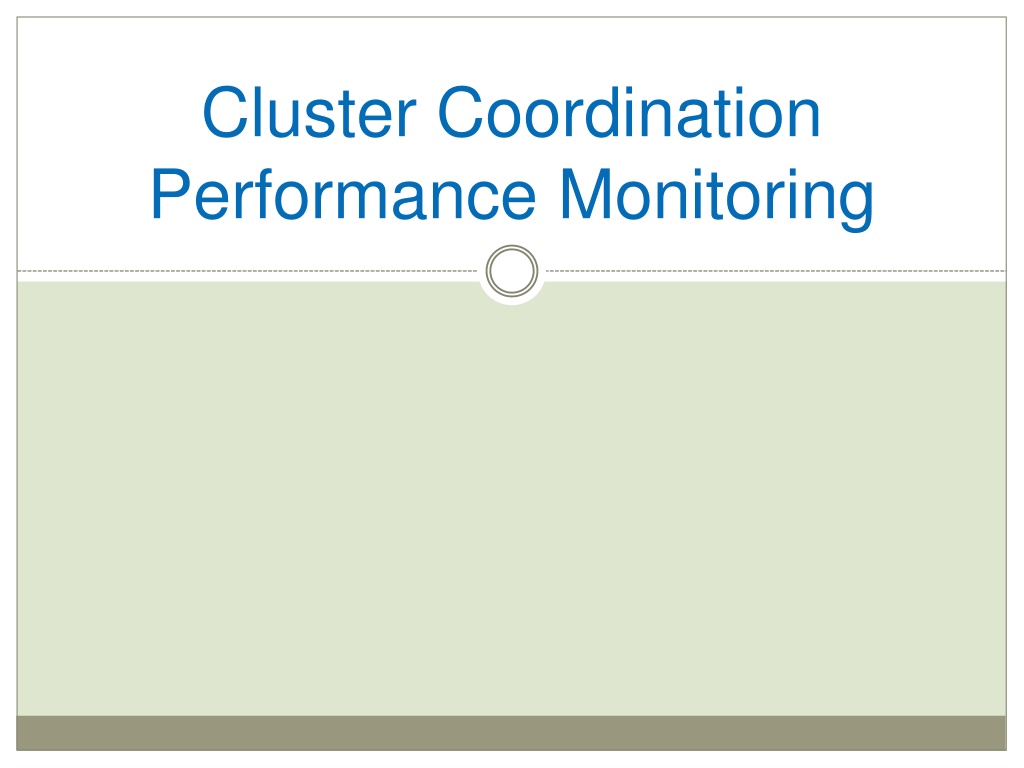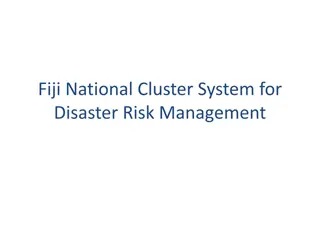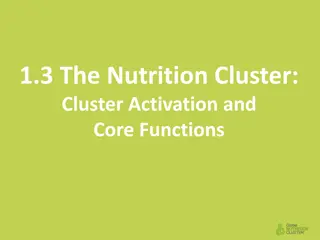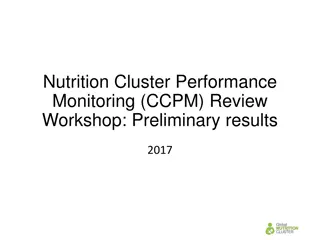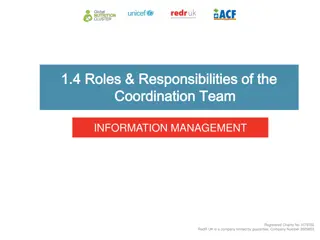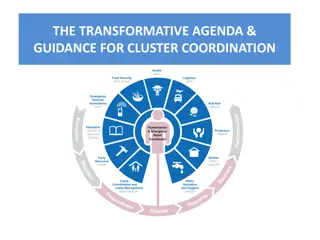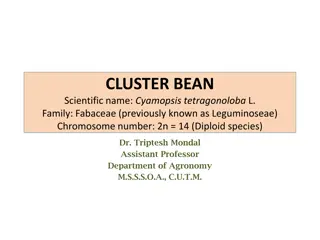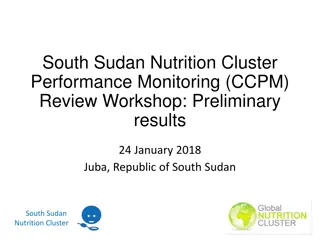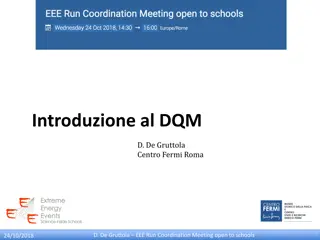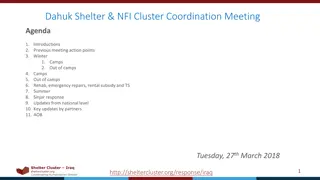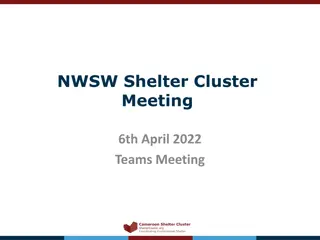Understanding Cluster Coordination Performance Monitoring (CCPM)
The Cluster Coordination Performance Monitoring (CCPM) is a self-assessment tool that helps evaluate cluster performance against core functions and Accountability to Affected Populations. It aims to improve coordination and accountability within clusters, developed by the IASC Sub-Working Group. Monitoring CCPM ensures efficient coordination, identifies areas for improvement, and enhances transparency and partnership. Implementing CCPM varies based on protracted crises or new emergencies, involving all clusters, global clusters, and OCHA-FO for support and engagement.
Download Presentation

Please find below an Image/Link to download the presentation.
The content on the website is provided AS IS for your information and personal use only. It may not be sold, licensed, or shared on other websites without obtaining consent from the author. Download presentation by click this link. If you encounter any issues during the download, it is possible that the publisher has removed the file from their server.
E N D
Presentation Transcript
Cluster Coordination Performance Monitoring
What is the CCPM? A self-assessment of cluster performance against the 6 core cluster functions and Accountability to Affected Populations (AAP): support service delivery inform the HC/HCT's strategic decision-making strategy development monitor and evaluate performance capacity building in preparedness and contingency planning. Advocacy + section on Accountability to Affected Populations A country-led process, supported by Global Clusters and OCHA The CCPM can be applied by both Clusters and sectors 1. 2. 3. 4. 5. 6. 7.
Where does the CCPM come from? Transformative Agenda Improve coordination and accountability Developed by the IASC Sub-Working Group (SWG) on the Cluster approach and endorsed by the IASC WG in 2012 Piloted in 2012 and implemented from 2013
Why monitor Cluster coordination performance? Ensure efficient and effective coordination Take stock of what functional areas work well and what areas need improvement Raise awareness of support needed from the HC/HCT, cluster lead agencies, global Clusters or Cluster partners Opportunity for self-reflection Strengthening transparency and partnership within a Cluster Show the added value and justify the costs of coordination
The CCPM does NOT Monitor response (service delivery) Evaluate individual partners or coordinators Evaluate if/when Clusters should be deactivated, merged etc. (Review of the Cluster architecture) Exclude usage of other tools with the same purpose
When to implement the CCPM? Protracted crises: Annually, but clusters decide when to implement it New emergencies: 3-6 months after the onset and once every year thereafter. If several core functions have been registered as weak, then, repeat more frequently Avoid simultaneous commitments (e.g. the Strategic Planning Process, donor visits etc.)
Who is involved? Ideally all Clusters (Cluster coordinators and partners) Global Clusters: technical and facilitation support OCHA-FO (Field Offices) coordinate across Clusters and ensure engagement of HC/HCT
CCPM in steps STEPS 3. Analysis Action Planning 1. Planning 2.Survey 4. Monitoring OUTPUTS Decision on implementation Preliminary Report Final Report & Action Plan Quarterly Reports to HCT
Step I: Planning HCT decision on CCPM timeframe and participation Inter-Cluster Coordination Group discussion Each Cluster meets to: Discuss the CCPM purpose, process, methodology and outputs; Clarify timeframe for; Survey start and end dates (approx. 2 weeks) Circulation of Preliminary Coordination Performance Report Cluster meeting to finalise the Coordination Performance Report (contextualise), including developing the Action Plan Clarify role of government counterpart Establish commitment to follow-up on agreed actions to improve performance Output I: Agreement on implementation and timeframe
Step II: The Survey Two online questionnaires: i. Coordination performance questionnaire, completed by the Cluster Coordinator, approx. 10 min ii. Coordination performance questionnaire, completed by the Cluster partners, approx. 10 min Important: Responses are anonymous but avoid sensitive comments Important to fully complete the questionnaire Survey results only shared externally after the Cluster has contextualised it
Step II: The Survey Analysis and scoring of performance status The score for each core function is calculated based on aggregated results of partners and coordinator. The score is classified into a 4 categories of performance status: Score Score Performance status Performance status >75% Green = Strong 51-75% Yellow = Satisfactory (needs minor improvement 26-50% Orange = Unsatisfactory (needs major improvement 25% Red = Weak
Step II: The Survey Output II: The survey results are compiled into a report
Step III: Cluster analysis and action planning Review/amend the Preliminary Report Explain/contextualize findings Identify actions for improvement (focus on weak and unsatisfactory performance), timeframe and responsible for follow-up Pinpoint support requirements
Step III: Cluster analysis and action planning Output III: Final CCPM and Action Plan Actions for improvement, timeframe and responsible for follow-up Awareness of support requirements (HC/HCT, Cluster Lead Agencies, Partners, OCHA, Global Clusters and national authorities) Shared with the HC/HCT and Global Cluster and, if applicable, the national authorities
Step IV: Follow-up & Monitoring Follow-up: ICC: Review of Reports/Action Plans identify common weaknesses to be addressed systematically. HCT: Presentation of Reports/Action Plans and discussion of support requirements Monitoring: Take stock of progress at monthly cluster meetings Quarterly progress reporting to the HCT Output IV: Quarterly reports to HCT
